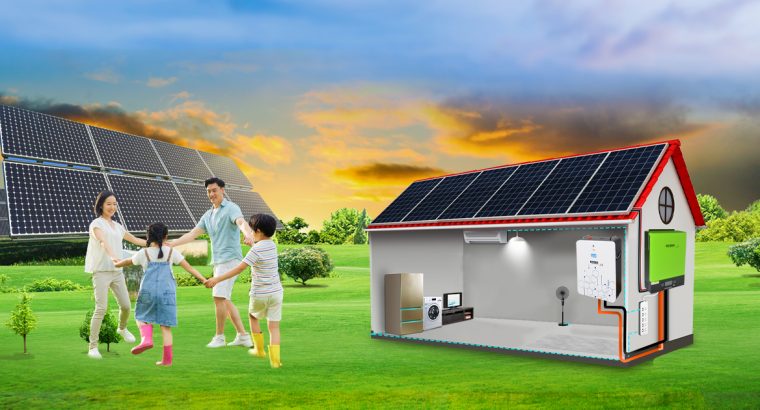LiFePO4 – The Key to Unlocking Solar Power’s Potential

Solar Power has become increasingly popular as the world looks for more sustainable energy sources.
One of the challenges with solar power is storing the energy for later use. LiFePO4 batteries are being touted as the future solar power storage solution. But are they really up to the task? This blog post will explore the pros and cons of LiFePO4 batteries as a solar power storage solution to help you make up your mind.

Storage Batteries are necessary to store the energy collected by solar panels. So that power can be used when the sun is not shining.
Battery for Solar System
A good energy storage battery is at the core of every solar system. Without a battery, it’s impossible to store the energy generated from solar panels. This makes choosing the right battery technology extremely crucial for retaining power during off-peak production periods (when the sun isn’t shining).
There are three different types of batteries used in off-grid solar systems:
-Flooded lead acid
-Sealed lead acid (Gel and AGM)
-Lithium iron phosphate (LiFePO4)
Flooded lead acid Battery
Flooded lead acid (FLA) batteries are wet cell batteries filled with electrolytes. While these are the cheapest batteries available, they have the shortest lifespan and require ongoing maintenance every 30-45 days. Regular maintenance includes refilling with water, venting, and cleaning the terminals.
FLA batteries require handling with care because it contains highly toxic and corrosive lead/ sulfuric acid. Improper maintenance of flooded lead acid batteries may result in the leakage of explosive hydrogen gas. Most manufacturers recommend replacing these batteries every 3-4 years or 500 discharge/ charge cycles.
Flooded lead acid (FLA) batteries have the longest track record in solar power use and are still used in most stand-alone alternative energy systems.
Sealed Lead Acid Batteries
Sealed lead acid batteries come at a slightly higher price point and work better for demanding off-grid power situations. AGM batteries are a part of this group and feature thin glass mats that hold the electrolyte in place. For the most part, sealed batteries are maintenance-free but must be replaced every 5-7 years, depending on usage.
Lithium Iron Phosphate (LiFePO4) Batteries
Battery cells with lithium iron phosphate technology (LiFePO4) are the best choice for modern solar systems of any type. Lithium-ion batteries are more reliable, more efficient at storing and supplying energy, recharge the fastest, and have the most extended life cycle (3000-7000 cycles). Lithium Battery Power offers several large-capacity lithium-ion batteries depending on your specific solar wattage needs. The only downside to lithium is the high upfront cost, but this is eventually offset over time. It’s not uncommon for high-quality lithium batteries to last up to 15 years.
Solar Power Storage Comparing Lead Acid and LiFePO4 Batteries
As battery technology continues to improve, the future of solar power looks even brighter. The future of solar power is looking bright – and lithium batteries are playing a significant role in making it happen. Solar Power is one of the most renewable and environmentally-friendly energy sources available. Lithium batteries are becoming increasingly popular as a way to store solar energy for use when the sun isn’t shining.

Lead acid batteries have been the traditional choice for solar power storage, but LiFePO4 batteries offer several advantages. Like Long Life, High energy density, Lightweight, and High DOD for more energy use.
LiFePO4 also doesn’t require maintenance as lead acid batteries do.
Using LFP batteries for solar power storage is an excellent way to take advantage of this clean, renewable energy source.
LiFePO4 storage batteries have emerged as a leading option for solar power storage because of their high capacity and relatively low running cost.
Are Lithium iron phosphate Batteries the Solar Power Storage Solution of the Future?
The future of solar power with LiFePO4 batteries is a hot topic with the ever-growing popularity of solar energy. More and more people are considering using LFP batteries for solar power storage.
LiFePO4 batteries are lighter in weight.
LFP batteries have higher energy density.
High DOD.
Lithium iron phosphate batteries can be charged and discharged more times than lead acid batteries.
In short, Value for money.
For more details about LiFePO4 Batteries please check here What is LiFePO4 Battery?
Comments are closed.

[…] is a type of lithium-ion rechargeable battery. Lithium Iron Phosphate batteries, also known as LFP or LiFePO4 batteries. It uses LiFePO4 as the cathode material & […]
[…] your home or business, and it doesn’t produce any harmful emissions But did you know that solar power can also help reduce your environmental […]
[…] lithium iron phosphate (LiFePO4 or LFP) battery is a type of rechargeable battery that has become increasingly popular for use in […]